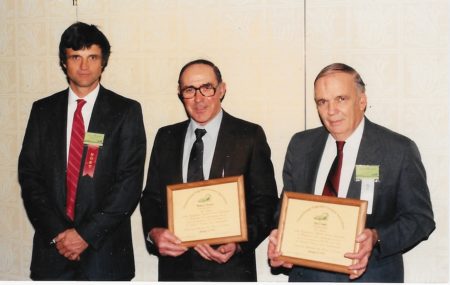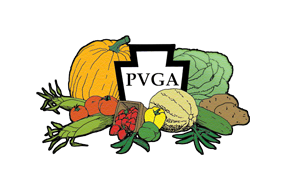PVGA Life Member – Cyril Smith

PVGA President Glenn Hetherington (left) shown with life members William Baronner (center) and Cyril Smith (right).
Dr. Smith retired in June 1989, as Professor of Plant Nutrition at Penn State. A native of Winnipeg in Manitoba, Canada, he came to State College 43 years ago as a Ph.D. candidate. A year later he joined the faculty in the Horticulture Department as an Instructor. He received his doctorate in 1950 and was promoted to full professor in 1965.
Dr. Smith was nationally and internationally known for his research in mineral nutrition and plant analysis of fruit trees, grapes and vegetables. He has conducted extensive lime and fertilizer experiments on vegetables. His largest vegetable project contained 40 experiments repeated for 3 years in 11 counties across Pennsylvania.
From this project Dr. Smith found that dolomitic lime supplied crops with magnesium very well but was not a good calcium source. Calcitic lime, however, was a good calcium source but actually tended to reduce magnesium uptake. Magnesium uptake is also reduced by potassium fertilizers but increased by nitrogen and phosphorus applications.
Dr. Smith’s work has shown that band application of fertilizers allows growers to use less fertilizer to obtain optimum yields than by broadcast applications. Penn State recommendations have been changed as a result and growers have found they can substantially reduce their fertilizer bills.
Dr. Smith has done extensive work with Dr. George Greene on apple calcium nutrition and the reduction of corking. He also studied grape nutrition resulting in improved recommendations for that crop. Besides conducting his field research, Dr. Smith supervised Penn State’s Plant Analysis Laboratory. He was placed in charge of this laboratory upon the retirement of his predecessor, Dr. Walter Thomas. From a small laboratory, Dr. Smith developed it into a large research and service laboratory capable of annually analyzing over 35,000 plant tissue samples for 9 elements with modern, computerized equipment. These samples come from researchers at Penn State and other institutions and agencies like NASA as well as from growers throughout Pennsylvania.
